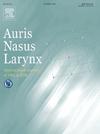Evaluation of real-time pharmacokinetics using fluorescence imaging system in Near-infrared photoimmunotherapy for head and neck cancer
IF 1.5
4区 医学
Q2 OTORHINOLARYNGOLOGY
引用次数: 0
Abstract
Objective
Near-infrared photoimmunotherapy (NIR-PIT) is a molecular targeted therapy that utilizes an antibody-photoabsorber conjugate and excitation light. Herein, excitation of antibody-bound IR700 with near-infrared light at 690 nm causes IR700 to undergo a photochemical ligand reaction. IR700’s hydrophilic side chain is released, and the remaining molecules became hydrophobic and lost fluorescence.
NIR-PIT targeting the epidermal growth factor receptor using cetuximab sarotalocan sodium, and a laser system has been used to treat patients with unresectable head and neck cancers in Japan since 2021. Light irradiates planned treatment area based on preoperative diagnostic imaging; however, the actual drug accumulation and response status during treatment have not been confirmed.
This study aimed to investigate NIR-PIT’s fluorescence intensity and antitumor effects on head and neck cancer in humans using real-time fluorescence imaging system.
Methods
In this single-center prospective observational study, patients with lesions that could be monitored fluorescence were enrolled. Fluorescence intensity during NIR-PIT and tumor characteristics before and after treatment were examined.
Results
Seven patients were included. The fluorescence intensity of the irradiated area showed a rapid decrease in the early stage of treatment, followed by a gradual decrease, almost reaching a plateau before the end of light irradiation. The irradiated areas demonstrated no fluorescence following re-irradiation, and areas irradiated in duplicate tended to lose fluorescence more rapidly than the non-overlapping areas.
Conclusion
We observed and measured the drug accumulation and responses during treatment in humans using real-time fluorescence imaging. This information is expected to be applied to evaluate efficacy of NIR-PIT.
利用荧光成像系统评价近红外光免疫治疗头颈部肿瘤的实时药代动力学
目的近红外光免疫治疗(NIR-PIT)是一种利用抗体-光吸收剂结合激发光的分子靶向治疗方法。本文中,用近红外光在690 nm处激发抗体结合的IR700,使IR700发生光化学配体反应。IR700的亲水侧链被释放,剩下的分子变成疏水分子,失去荧光。NIR-PIT靶向表皮生长因子受体,使用西妥昔单抗沙罗他罗坎钠和激光系统,自2021年以来在日本用于治疗不可切除的头颈癌患者。根据术前诊断成像,光照射计划治疗区域;然而,在治疗过程中实际的药物积累和反应状况尚未得到证实。本研究旨在利用实时荧光成像系统研究NIR-PIT的荧光强度及其对人头颈部肿瘤的抗肿瘤作用。方法在这项单中心前瞻性观察研究中,纳入了可监测荧光病变的患者。检测NIR-PIT期间荧光强度及治疗前后肿瘤特征。结果纳入7例患者。照射区域的荧光强度在处理初期迅速下降,随后逐渐下降,在光照射结束前几乎达到平台。辐照区域在再辐照后没有荧光,重复辐照的区域比不重叠的区域更容易失去荧光。结论采用实时荧光成像技术观察并测量了药物在人体治疗过程中的积累和反应。这些信息有望用于评价NIR-PIT的疗效。
本文章由计算机程序翻译,如有差异,请以英文原文为准。
求助全文
约1分钟内获得全文
求助全文
来源期刊

Auris Nasus Larynx
医学-耳鼻喉科学
CiteScore
3.40
自引率
5.90%
发文量
169
审稿时长
30 days
期刊介绍:
The international journal Auris Nasus Larynx provides the opportunity for rapid, carefully reviewed publications concerning the fundamental and clinical aspects of otorhinolaryngology and related fields. This includes otology, neurotology, bronchoesophagology, laryngology, rhinology, allergology, head and neck medicine and oncologic surgery, maxillofacial and plastic surgery, audiology, speech science.
Original papers, short communications and original case reports can be submitted. Reviews on recent developments are invited regularly and Letters to the Editor commenting on papers or any aspect of Auris Nasus Larynx are welcomed.
Founded in 1973 and previously published by the Society for Promotion of International Otorhinolaryngology, the journal is now the official English-language journal of the Oto-Rhino-Laryngological Society of Japan, Inc. The aim of its new international Editorial Board is to make Auris Nasus Larynx an international forum for high quality research and clinical sciences.
 求助内容:
求助内容: 应助结果提醒方式:
应助结果提醒方式:


